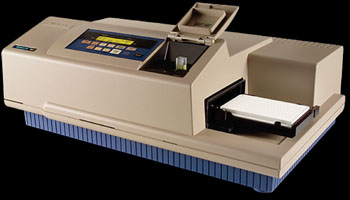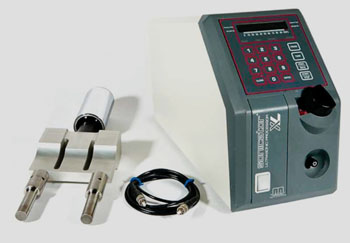Ферментный анализ на пропитанной фильтровальной бумаге выявляет болезнь Краббе
|
By LabMedica International staff writers Posted on 12 Feb 2015 |

Спектрофлуорометр SpectraMax M2 (фото любезно предоставлено Molecular Devices).

Спектрофлуорометр SpectraMax M2 (фото любезно предоставлено Molecular Devices).
Болезнь Краббе (БК) является наследственной лизосомной болезнью накопления (LSD), вызываемой дефицитом галактоцереброзидазы (GALC), и характеризуется тяжелой и прогрессирующей лейкодистрофией с наступлением смерти часто в пределах одного года жизни.
Образцы высушенной крови на фильтровальной бумаге (DBFP) все чаще используются для анализа лизосомальных ферментов, и некоторые из лизосомальных ферментов не могут быть проверены на образцах DBFP с помощью флуорометрическиех анализов, в том числе GALC, гепаран-сульфамидаза (heparan-sulfamidase) и некоторые другие.
Медицинские генетики из больницы de Clínicas de Porto Alegre (Бразилия) получили лейкоциты от здоровых людей и подтвердили диагноз пациентов с БК. Образцы фильтровальной бумаги с высушенными лейкоцитами (DLFP) были подготовлены разбавлением осадка лейкоцитов в дистиллированной воде, и раствор был смешан и обработан ультразвуком в ледяной ванне на Misonix Sonicator XL2020 (Qsonica; Ньютаун, штат Коннектикут, США). После выдерживания в термостате с подходящими подложками надосадочная жидкость измерялась на спектрофлуорометре SpectraMax M2 (Molecular Devices; Саннивейл, штат Калифорния, США).
При сопоставлении активности GALC в DLFP и соответствующих им образцах лейкоцитов можно было увидеть тесную корреляцию в соответствующих группах БКД. Здоровая контрольная группа показала более высокие значения активности в DLFP, в какой-то степени возможно из-за удержания белка в фильтровальной бумаге в процессе разбавления. Исследователи не визуализировали этот эффект в образцах БК вероятно потому, что флуоресценция этих образцов была очень низкой. Тем не менее анализ в DLFP позволил правильно определить пациентов с БК во всех случаях.
Авторы пришли к выводу, что анализ GALC на DLFP является надежным и эффективным методом идентификации БК. Так как подготовка образца является вполне реализуемой в стандартных биохимических лабораториях и легка в транспортировке, это может позволить пациентам, проживающим в отдаленных районах, быть обследованными и диагностированными. Исследование было опубликовано 1 января 2015 года в журнале Clinica Chimica Acta.
Ссылки по теме:
Hospital de Clínicas de Porto Alegre
Qsonica
Molecular Devices
Образцы высушенной крови на фильтровальной бумаге (DBFP) все чаще используются для анализа лизосомальных ферментов, и некоторые из лизосомальных ферментов не могут быть проверены на образцах DBFP с помощью флуорометрическиех анализов, в том числе GALC, гепаран-сульфамидаза (heparan-sulfamidase) и некоторые другие.
Медицинские генетики из больницы de Clínicas de Porto Alegre (Бразилия) получили лейкоциты от здоровых людей и подтвердили диагноз пациентов с БК. Образцы фильтровальной бумаги с высушенными лейкоцитами (DLFP) были подготовлены разбавлением осадка лейкоцитов в дистиллированной воде, и раствор был смешан и обработан ультразвуком в ледяной ванне на Misonix Sonicator XL2020 (Qsonica; Ньютаун, штат Коннектикут, США). После выдерживания в термостате с подходящими подложками надосадочная жидкость измерялась на спектрофлуорометре SpectraMax M2 (Molecular Devices; Саннивейл, штат Калифорния, США).
При сопоставлении активности GALC в DLFP и соответствующих им образцах лейкоцитов можно было увидеть тесную корреляцию в соответствующих группах БКД. Здоровая контрольная группа показала более высокие значения активности в DLFP, в какой-то степени возможно из-за удержания белка в фильтровальной бумаге в процессе разбавления. Исследователи не визуализировали этот эффект в образцах БК вероятно потому, что флуоресценция этих образцов была очень низкой. Тем не менее анализ в DLFP позволил правильно определить пациентов с БК во всех случаях.
Авторы пришли к выводу, что анализ GALC на DLFP является надежным и эффективным методом идентификации БК. Так как подготовка образца является вполне реализуемой в стандартных биохимических лабораториях и легка в транспортировке, это может позволить пациентам, проживающим в отдаленных районах, быть обследованными и диагностированными. Исследование было опубликовано 1 января 2015 года в журнале Clinica Chimica Acta.
Ссылки по теме:
Hospital de Clínicas de Porto Alegre
Qsonica
Molecular Devices
Latest Химия News
Channels
Clinical Chemistry
view channel
AI-Powered Blood Test Accurately Detects Ovarian Cancer
Ovarian cancer ranks as the fifth leading cause of cancer-related deaths in women, largely due to late-stage diagnoses. Although over 90% of women exhibit symptoms in Stage I, only 20% are diagnosed in... Read more
Automated Decentralized cfDNA NGS Assay Identifies Alterations in Advanced Solid Tumors
Current circulating cell-free DNA (cfDNA) assays are typically centralized, requiring specialized handling and transportation of samples. Introducing a flexible, decentralized sequencing system at the... Read more
Mass Spectrometry Detects Bacteria Without Time-Consuming Isolation and Multiplication
Speed and accuracy are essential when diagnosing diseases. Traditionally, diagnosing bacterial infections involves the labor-intensive process of isolating pathogens and cultivating bacterial cultures,... Read more
First Comprehensive Syphilis Test to Definitively Diagnose Active Infection In 10 Minutes
In the United States, syphilis cases have surged by nearly 80% from 2018 to 2023, with 209,253 cases recorded in the most recent year of data. Syphilis, which can be transmitted sexually or from mother... Read moreMolecular Diagnostics
view channel
Microbial Cell-Free DNA Test Accurately Identifies Pathogens Causing Pneumonia and Other Lung Infections
Bronchoalveolar lavage (BAL) is a commonly used procedure for diagnosing lung infections, especially in immunocompromised patients. However, standard tests often fail to pinpoint the exact pathogen, leading... Read more
Non-Biopsy Approach to Transform Adult Celiac Disease Diagnoses
In the United States, the diagnosis of celiac disease in adults typically relies on a combination of serologic testing and a confirmatory small bowel biopsy during upper endoscopy. In contrast, European... Read moreHematology
view channel
First Point-of-Care Heparin Monitoring Test Provides Results in Under 15 Minutes
Heparin dosing requires careful management to avoid both bleeding and clotting complications. In high-risk situations like extracorporeal membrane oxygenation (ECMO), mortality rates can reach about 50%,... Read more
New Scoring System Predicts Risk of Developing Cancer from Common Blood Disorder
Clonal cytopenia of undetermined significance (CCUS) is a blood disorder commonly found in older adults, characterized by mutations in blood cells and a low blood count, but without any obvious cause or... Read moreImmunology
view channel
Stem Cell Test Predicts Treatment Outcome for Patients with Platinum-Resistant Ovarian Cancer
Epithelial ovarian cancer frequently responds to chemotherapy initially, but eventually, the tumor develops resistance to the therapy, leading to regrowth. This resistance is partially due to the activation... Read more
Machine Learning-Enabled Blood Test Predicts Immunotherapy Response in Lymphoma Patients
Chimeric antigen receptor (CAR) T-cell therapy has emerged as one of the most promising recent developments in the treatment of blood cancers. However, over half of non-Hodgkin lymphoma (NHL) patients... Read moreMicrobiology
view channel
New Blood Test Detects Up to Five Infectious Diseases at POC
Researchers have developed a prototype flow-through assay capable of detecting up to five different infections, with results that can be quickly analyzed and transmitted via a specialized smartphone app.... Read more
Molecular Stool Test Shows Potential for Diagnosing TB in Adults with HIV
Tuberculosis (TB), caused by the bacterium Mycobacterium tuberculosis, led to 1.25 million deaths in 2023, with 13% of those occurring in people living with HIV. The current primary diagnostic method for... Read morePathology
view channel
Groundbreaking Chest Pain Triage Algorithm to Transform Cardiac Care
Cardiovascular disease is responsible for a third of all deaths worldwide, and chest pain is the second most common reason for emergency department (ED) visits. With EDs often being some of the busiest... Read more
AI-Based Liquid Biopsy Approach to Revolutionize Brain Cancer Detection
Detecting brain cancers remains extremely challenging, with many patients only receiving a diagnosis at later stages after symptoms like headaches, seizures, or cognitive issues appear. Late-stage diagnoses... Read moreTechnology
view channel
Advanced Predictive Algorithms Identify Patients Having Undiagnosed Cancer
Two newly developed advanced predictive algorithms leverage a person’s health conditions and basic blood test results to accurately predict the likelihood of having an undiagnosed cancer, including ch... Read more
Light Signature Algorithm to Enable Faster and More Precise Medical Diagnoses
Every material or molecule interacts with light in a unique way, creating a distinct pattern, much like a fingerprint. Optical spectroscopy, which involves shining a laser on a material and observing how... Read more
Disposable Microchip Technology Could Selectively Detect HIV in Whole Blood Samples
As of the end of 2023, approximately 40 million people globally were living with HIV, and around 630,000 individuals died from AIDS-related illnesses that same year. Despite a substantial decline in deaths... Read more
Pain-On-A-Chip Microfluidic Device Determines Types of Chronic Pain from Blood Samples
Chronic pain is a widespread condition that remains difficult to manage, and existing clinical methods for its treatment rely largely on self-reporting, which can be subjective and especially problematic... Read moreIndustry
view channel
Cepheid and Oxford Nanopore Technologies Partner on Advancing Automated Sequencing-Based Solutions
Cepheid (Sunnyvale, CA, USA), a leading molecular diagnostics company, and Oxford Nanopore Technologies (Oxford, UK), the company behind a new generation of sequencing-based molecular analysis technologies,... Read more
Grifols and Tecan’s IBL Collaborate on Advanced Biomarker Panels
Grifols (Barcelona, Spain), one of the world’s leading producers of plasma-derived medicines and innovative diagnostic solutions, is expanding its offer in clinical diagnostics through a strategic partnership... Read more





















